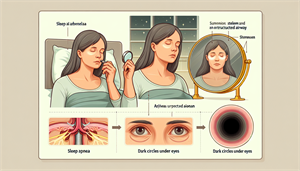
Can Sleep Apnea Cause Dark Circles Under Eyes?
Yes, interruptions in sleep caused by sleep apnea can lead to substantial under-eye shadows. The reasons behind these unsightly dark circles include frequent sleep disruptions, fluid buildup, and reduced blood and oxygen flow, resulting in exhaustion, puffiness, and dark circles.
Unveiling the Connection: Sleep Apnea and Under-Eye Circles
Sleep apnea, a sleep disorder marked by significant disruptions in breathing patterns, is more common than you think. Frequent sleep disruptions, a common symptom of sleep apnea, often result in fatigue, prompting fluid build-up under the eyes, leading to the development of dark circles and puffiness. Even if you’re clocking enough hours in bed every night, undiagnosed sleep apnea could still be causing dark circles under your eyes.
The Breathing Barrier: How Stopped Breathing at Night Affects Your Eyes
Reduced oxygen and blood flow due to sleep apnea can lead to eye problems, including dark circles. Sleep apnea results in repeated periods of halted respiration, leading to intermittent hypoxia and hypercapnia, conditions that can result in puffy eyes and dark circles. Melanin, the pigment that gives your skin its color, is the main factor influencing dark circles, but oxygen saturation and conditions impacting oxygen supply can also play a part.
Daytime Fatigue and Its Visible Signs
Sleep apnea also leads to daytime fatigue, which can manifest as dark circles and other signs on your face. Sleep deprivation can significantly impact your daytime sleepiness, concentration, cognitive ability, and ability to perform daily tasks. Regular and sufficient sleep can help diminish and potentially eliminate dark circles under the eyes.


